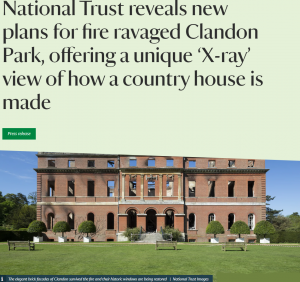 The National Trust has announced a new approach for Clandon Park, the early 18th-century house in Surrey, designed by the innovative Italian architect Giacomo Leoni and catastrophically damaged by fire in April 2015.
The National Trust has announced a new approach for Clandon Park, the early 18th-century house in Surrey, designed by the innovative Italian architect Giacomo Leoni and catastrophically damaged by fire in April 2015.
… fire at Clandon stripped most of the house completely bare…
The National Trust writes:
… The fire was the most devastating in the Trust’s history. It completely destroyed the roof, many of the internal walls and floors, along with most of the decorative interiors, leaving a brick shell, open to the elements and filled with several feet of fire-damaged collections and building debris…
Immediately after the fire, work had to focus on protecting and stabilising the building and painstakingly salvaging damaged collections and building material. Over subsequent years, specialist research and investigative conservation has revealed more and more about how the house was originally designed, constructed and decorated. The Trust’s new approach to Clandon responds to the evocative spaces created by the fire and the findings the team have uncovered.
National Trust Director-General Hilary McGrady said: “Our new plans for Clandon promise the very best future for this house – conserve and preserve what survives to the highest standard, and provide a peerless visitor experience using state of the art accessibility and interpretation that will break new ground for our understanding and appreciation of how great houses like Clandon were originally built and crafted.”
The interiors today consist of dramatic fire-damaged spaces, some rising from the basement to the sky. These will be conserved and made fully accessible in their fire-damaged state. The Trust plans to introduce sensitively designed walkways and platforms to enable visitors to explore the interiors at different levels, alongside a new roof with public terraces and roof lights that will illuminate Clandon’s dramatic spaces. Visitors will be able to access the new roof and view the interior spaces of the house from above, as well as the breath-taking surrounding countryside.
Project Director Kent Rawlinson said: “Since the fire, curators, archaeologists, craftspeople and other specialists have learnt so much about and from Clandon. We’ve welcomed more than 70,000 people, and their responses have shown us how powerful and exciting Clandon is today. It’s such an evocative, unusual place, and people respond to it in so many ways. We’ve had artists, scientists, engineers, designers, tradespeople, young children, all respond with awe.
The fire at Clandon stripped most of the house completely bare, leaving only fragments of decoration, making our original plans for restoration of some of the ground floor interior spaces extremely challenging. Given how little of the original decorative interiors survive, it would be less a case of restoration than of complete modern replication, and that wouldn’t be the right approach to take.”
Duncan Wilson, Historic England Chief Executive said: “The fire at Clandon in 2015 was a tragic event, rendering most of the building little but a shell, with the extraordinary survival of some rich decorative features and fragmentary details. We are encouraged by the thoughtful approach being suggested by the Trust, which will give new opportunities for learning and craft skills training.”
New infrastructure will give the house’s interior a new lease of life, enabling events, displays, and creative uses of the space, including re-display of saved collections. Approximately 600 items from the original collection were saved from the house during the fire, including paintings, furniture, ceramics, and textiles. A creative approach will be taken to displaying these within the house, using them to illuminate craft and art processes, their skilled makers and to tell stories of the many people who lived and worked at Clandon.
Expert craftspeople are currently repairing the exterior of the house – its historic brickwork, arches and doorways – in what is itself one of the Trust’s largest ever conservation projects. Clandon will look from the outside as it did before the fire. The Trust has, however, moved away from earlier plans to restore some ground floor rooms. These will now be conserved and curated in their laid-bare condition, except the one space that survived the fire, the Speakers’ Parlour.
The Trust’s Deputy Chair and former Director of the National Portrait Gallery Sandy Nairne said: “Clandon Park remains a great house today, physically laid bare and stripped back to its skeleton-like core. The Trust’s plans for Clandon are grounded in respect for the house’s history and design. They give Clandon a distinct purpose for the future, as a place to explore its architectural spaces, as well as the craft skills and people who made this and similar great houses across the country.”
Clandon Park volunteer Sara King said: “Every time I go inside Clandon my breath is taken away at the scale of destruction, and the disbelief that the immense walls topped by a regimental line of chimney pots are still standing – along with the Rysbrack reliefs and Carrara marble floors. There is real excitement and energy about this new vision. The team are carefully balancing the restoration and stabilisation of the fabric of the building, whilst aligning Clandon’s history and stories both past and present with inspiring uses and activities that reach out and relate to life in the 21st century, and beyond. In short, Clandon’s fire is the catalyst for providing an 18th century country house with new meaning and a renewed incentive to exist.”
The National Trust has completed initial feasibility work for the new approach and detailed designs will now be developed by architects Allies and Morrison for planning and statutory approvals. The conservation and repair of the brick and stone shell will continue in parallel.
The Trust estimates that the whole project will be completed by late 2027-28, depending on the duration of the construction programme.

